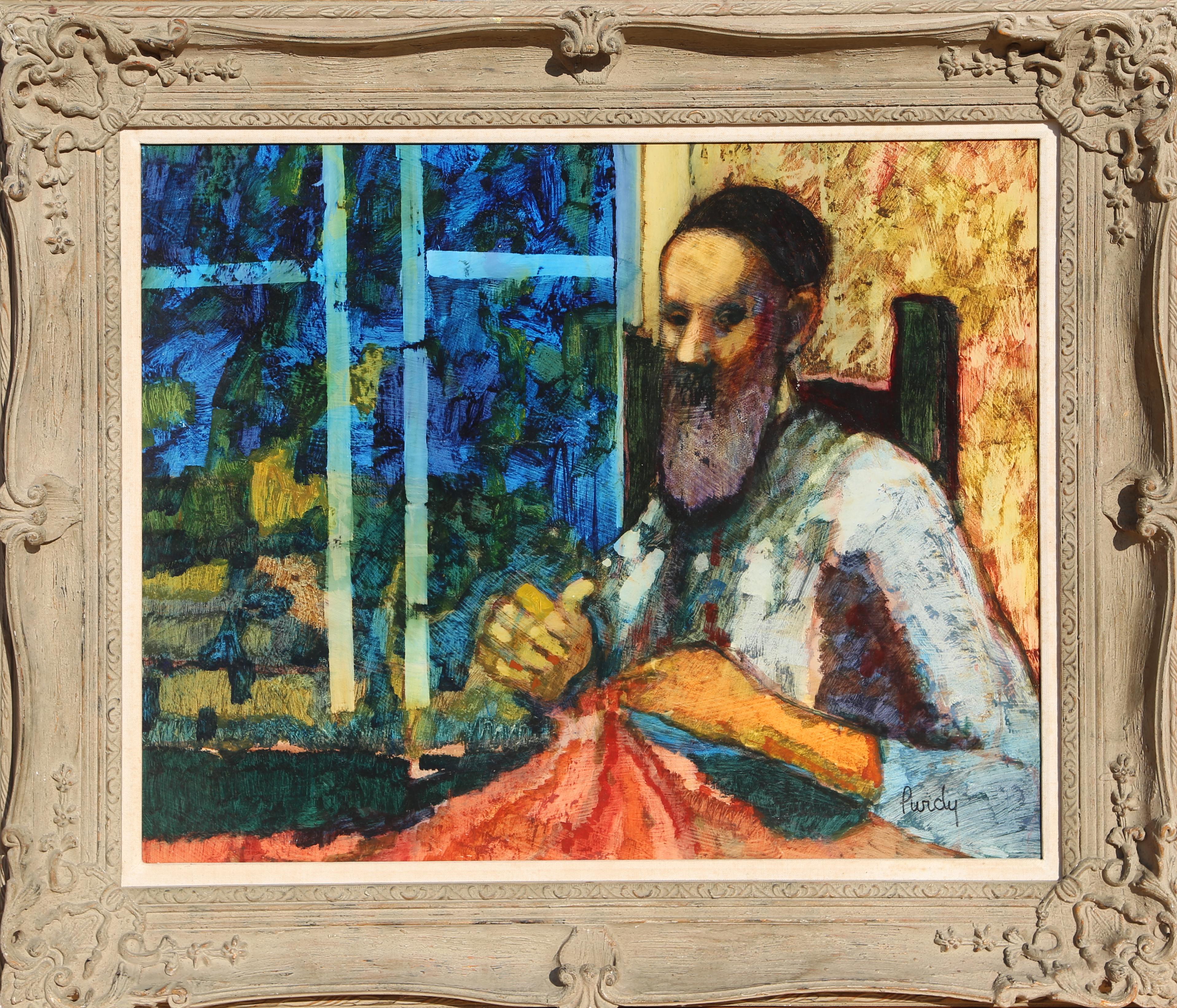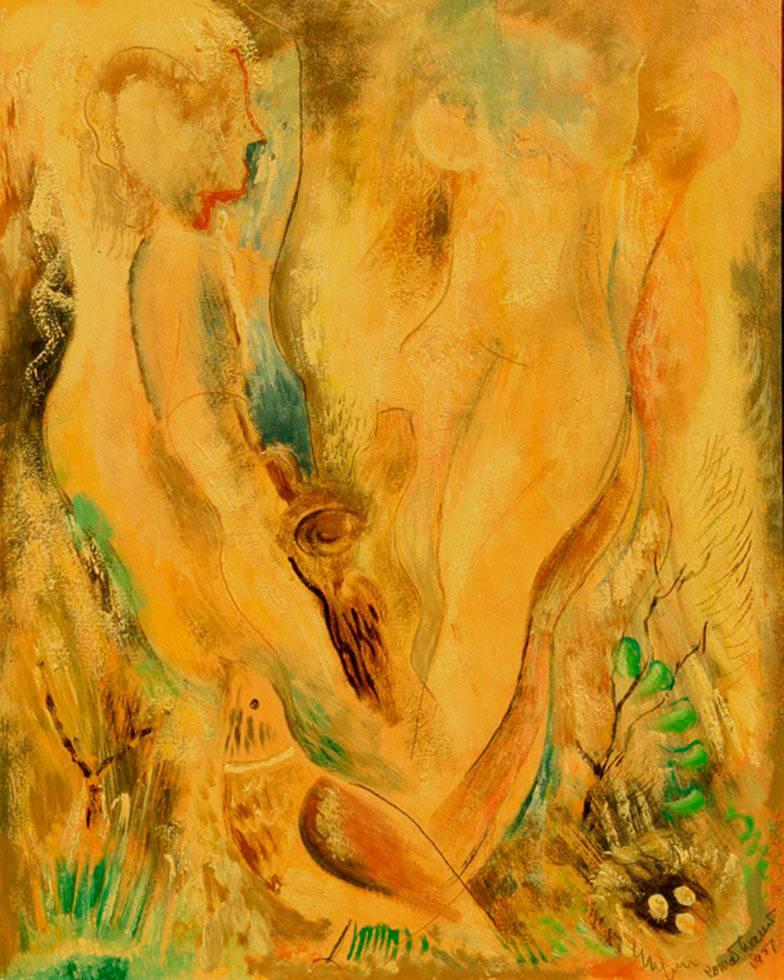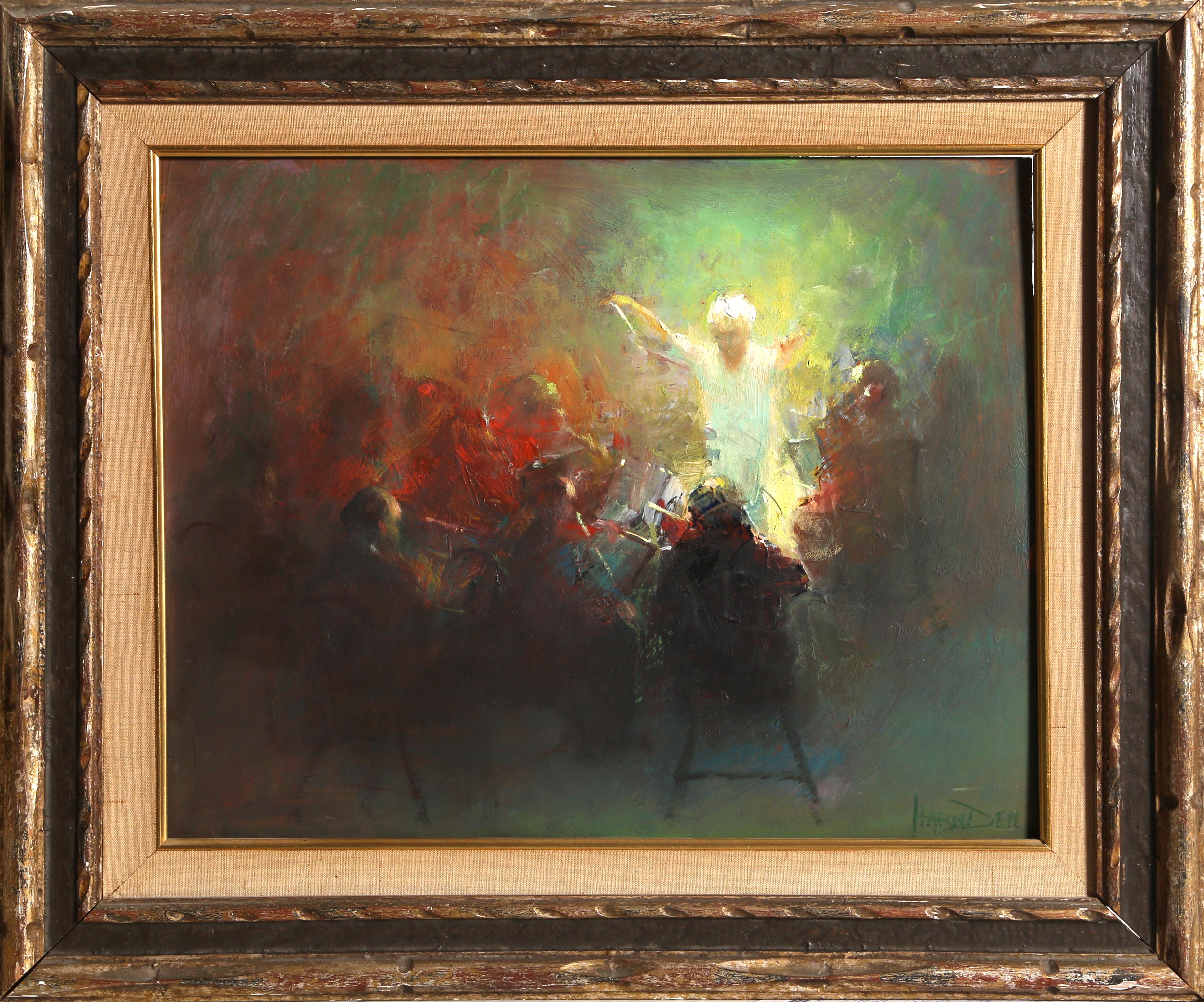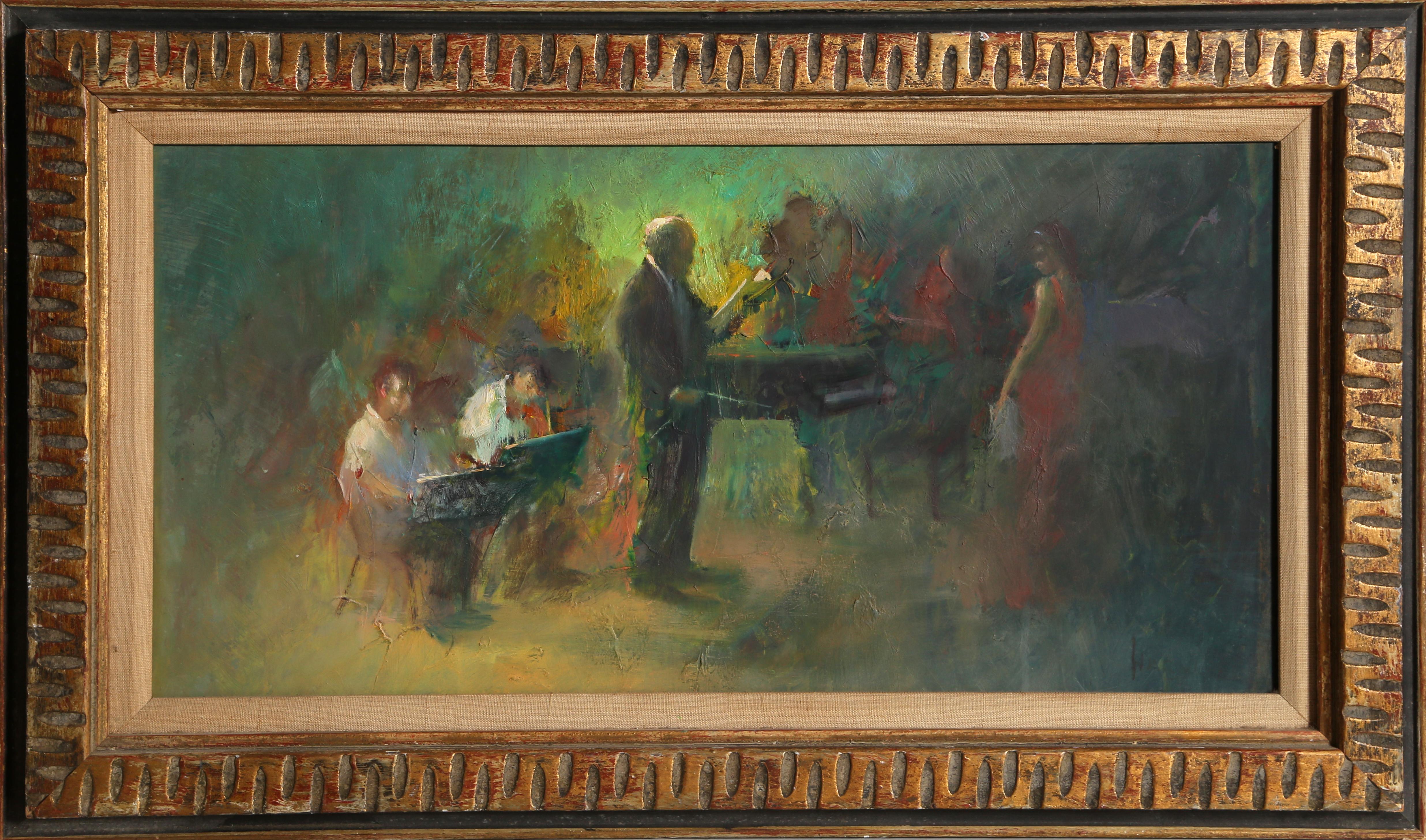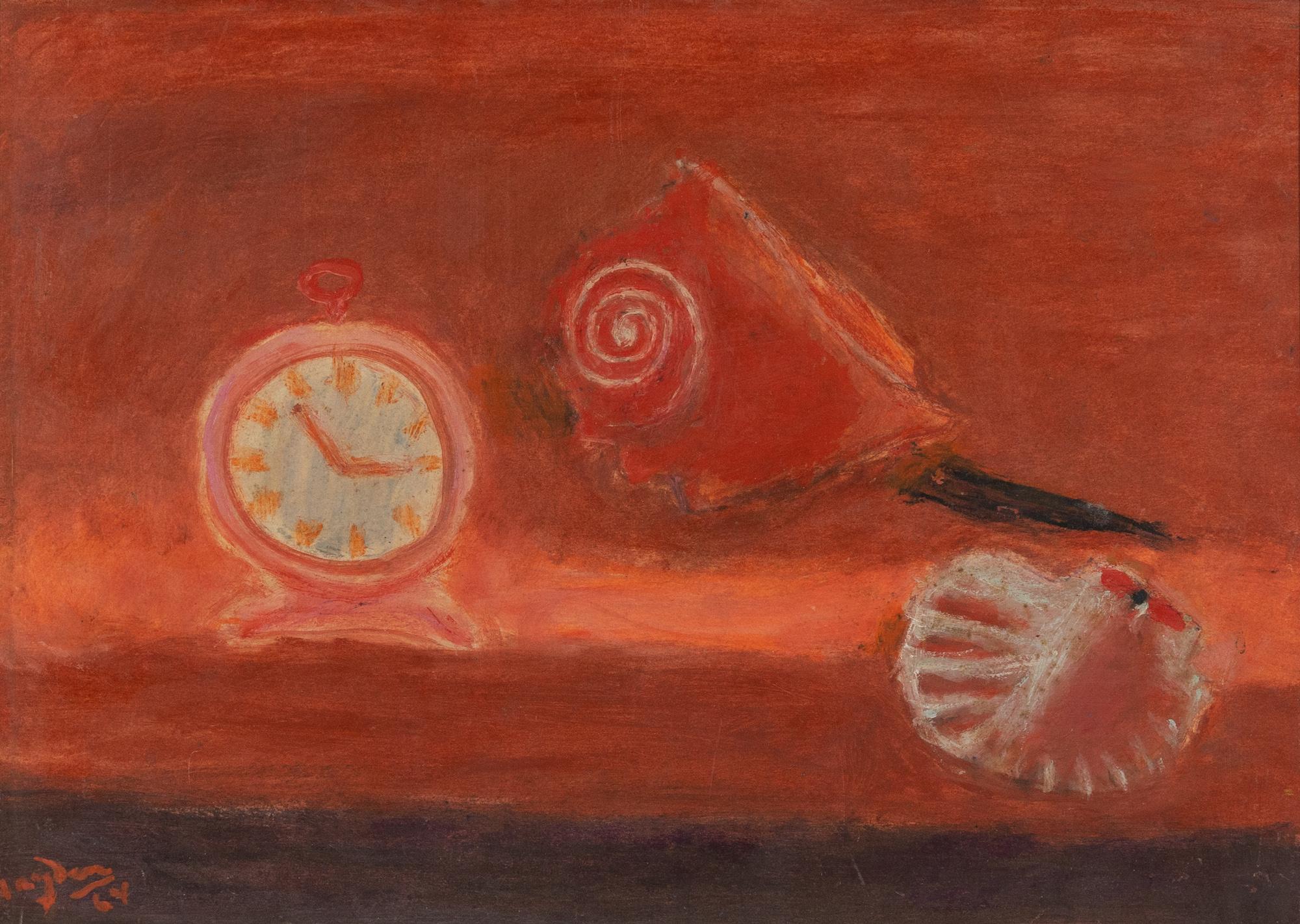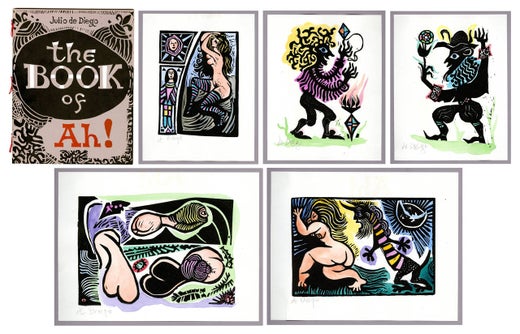Julio de DiegoHomage to the Spanish Republic by Julio De Diego
About the Item
- Creator:Julio de Diego (1900-1979, American)
- Dimensions:Height: 36 in (91.44 cm)Width: 30 in (76.2 cm)
- Medium:
- Movement & Style:
- Period:
- Condition:This artwork is in very good original condition consistent with age of painting.
- Gallery Location:Hudson, NY
- Reference Number:
Julio de Diego
Julio De Diego was one of the most colorful artists to work in Chicago. Born in Madrid in 1900, he left home at the age of 15 to apprentice as a scene painter for theatres. After service in the Spanish army, including six months fighting in North Africa, Diego traveled to Paris and Rome to study art. He also appeared as an extra in Diaghilev’s Ballet Russes. He emigrated to the United States in 1924. He lived in New York for two years, then went to Chicago, where he remained until 1942. At first, he earned a living as a magazine illustrator, decorative painter and graphic designer. By the early 1930s, Diego began to show regularly at the Art Institute of Chicago, appearing at thirty-two annual exhibitions of Chicago Artists, American artists and watercolorists, between 1931–47. He was employed by the easel division of the Illinois Art Project during the mid-1930s. He traveled to Mexico for the first time in 1939, becoming close friends with Carlos Mérida. Diego was deeply affected by the Spanish Civil War, and many of his works reflect the conflict that presaged the Second World War. Meditation over Inexplicable Logic seems to be a kind of preparation for his self-portrait in the Art Institute’s collection, titled The Perplexity of What To Do (1940). Both feature isolated, brooding figures lost in their inability to respond to events. He left Chicago in 1942 but continued to exhibit his work at major institutions. In 1946, Life magazine’s article described him spending time “cooking aromatic Spanish dishes and reading works of Spanish mystical philosophers and poets. He smokes cigarettes incessantly and dresses flamboyantly, affecting cerise mufflers and jangling bracelets.” Diego gained more notoriety in 1948 when he married the great burlesque artist, Gypsy Rose Lee. After their separation and divorce in the mid-1950s, he lived for a time in New York at the Chelsea Hotel, a haunt of artists, musicians and poets. Diego settled in Sarasota, Florida in 1967, near former friends from Chicago, where he died in 1979. Daniel Schulman References “Julio De Diego: He Paints Weird War and Peace.” Life Magazine, March 11, 1946. De Diego, Julio. Pamphlet File P-07866. Ryerson Library, Art Institute of Chicago.
- ShippingRetrieving quote...Ships From: Hudson, NY
- Return PolicyThis item cannot be returned.
- St. Atomic oil and tempera painting by Julio de DiegoBy Julio de DiegoLocated in Hudson, NYJulio De Diego’s Atomic Series paintings made an extraordinary statement regarding the shock and fear that accompanied the dawn of the nuclear age. In the artist’s own words, “Scientists were working secretly to develop formidable powers taken from the mysterious depths of the earth - with the power to make the earth useless! Then, the EXPLOSION! . . . we entered the Atomic Age, and from there the neo-Atomic war begins. Explosions fell everywhere and man kept on fighting, discovering he could fight without flesh.” To execute these works, De Diego developed a technique of using tempera underpainting before applying layer upon layer of pigmented oil glazes. The result is paintings with surfaces which were described as “bonelike” in quality. The forms seem to float freely, creating a three-dimensional visual effect. In the 1954 book The Modern Renaissance in American Art, author Ralph Pearson summarizes the series as “a fantastic interpretation of a weighty theme. Perhaps it is well to let fantasy and irony appear to lighten the devastating impact. By inverse action, they may in fact increase its weight.” Exhibited 1950 University of Illinois at Urbana "Contemporary American Painting" 1964 Marion Koogler McNay Art Institute, San Antonio, Texas This work retains its original frame which measures 54" x 36" x 2". About this artist: Julio De Diego crafted a formidable persona within the artistic developments and political struggles of his time. The artist characterized his own work as “lyrical,” explaining, “through the years, the surrealists, the social-conscious painters and the others tried to adopt me, but I went my own way, good, bad or indifferent.” [1] His independence manifested early in life when de Diego left his parent’s home in Madrid, Spain, in adolescence following his father’s attempts to curtail his artistic aspirations. At the age of fifteen he held his first exhibition, set up within a gambling casino. He managed to acquire an apprenticeship in a studio producing scenery for Madrid’s operas, but moved from behind the curtains to the stage, trying his hand at acting and performing as an extra in the Ballet Russes’ Petrouchka with Nijinsky. He spent several years in the Spanish army, including a six-month stretch in the Rif War of 1920 in Northern Africa. His artistic career pushed ahead as he set off for Paris and became familiar with modernism’s forays into abstraction, surrealism, and cubism. The artist arrived in the U.S. in 1924 and settled in Chicago two years later. He established himself with a commission for the decoration of two chapels in St. Gregory’s Church. He also worked in fashion illustration, designed magazine covers and developed a popular laundry bag for the Hotel Sherman. De Diego began exhibiting through the Art Institute of Chicago in 1929, and participated in the annual Chicago Artists Exhibitions, Annual American Exhibitions, and International Water Color Exhibitions. He held a solo exhibition at the Art Institute of Chicago in the summer of 1935. Though the artist’s career was advancing, his family life had deteriorated. In 1932 his first marriage dissolved, and the couple’s young daughter Kiriki was sent to live with friend Paul Hoffman. De Diego continued to develop his artistic vocabulary with a growing interest in Mexican art. He traveled throughout the country acquainting himself with the works of muralists such as Carlos Merida, and also began a collection of small native artifacts...Category
1940s American Modern Abstract Paintings
MaterialsMasonite, Oil, Tempera
- Inevitable Day – Birth of the Atom oil and tempera painting by Julio De DiegoBy Julio de DiegoLocated in Hudson, NYJulio De Diego’s Atomic Series paintings made an extraordinary statement regarding the shock and fear that accompanied the dawn of the nuclear age. In the artist’s own words, “Scientists were working secretly to develop formidable powers taken from the mysterious depths of the earth - with the power to make the earth useless! Then, the EXPLOSION! . . . we entered the Atomic Age, and from there the neo-Atomic war begins. Explosions fell everywhere and man kept on fighting, discovering he could fight without flesh.” To execute these works, De Diego developed a technique of using tempera underpainting before applying layer upon layer of pigmented oil glazes. The result is paintings with surfaces which were described as “bonelike” in quality. The forms seem to float freely, creating a three-dimensional visual effect. In the 1954 book The Modern Renaissance in American Art, author Ralph Pearson summarizes the series as “a fantastic interpretation of a weighty theme. Perhaps it is well to let fantasy and irony appear to lighten the devastating impact. By inverse action, they may in fact increase its weight.” Bibliography Art in America, April 1951, p.78 About this artists: Julio De Diego crafted a formidable persona within the artistic developments and political struggles of his time. The artist characterized his own work as “lyrical,” explaining, “through the years, the surrealists, the social-conscious painters and the others tried to adopt me, but I went my own way, good, bad or indifferent.” [1] His independence manifested early in life when de Diego left his parent’s home in Madrid, Spain, in adolescence following his father’s attempts to curtail his artistic aspirations. At the age of fifteen he held his first exhibition, set up within a gambling casino. He managed to acquire an apprenticeship in a studio producing scenery for Madrid’s operas, but moved from behind the curtains to the stage, trying his hand at acting and performing as an extra in the Ballet Russes’ Petrouchka with Nijinsky. He spent several years in the Spanish army, including a six-month stretch in the Rif War of 1920 in Northern Africa. His artistic career pushed ahead as he set off for Paris and became familiar with modernism’s forays into abstraction, surrealism, and cubism. The artist arrived in the U.S. in 1924 and settled in Chicago two years later. He established himself with a commission for the decoration of two chapels in St. Gregory’s Church. He also worked in fashion illustration, designed magazine covers and developed a popular laundry bag for the Hotel Sherman. De Diego began exhibiting through the Art Institute of Chicago in 1929, and participated in the annual Chicago Artists Exhibitions, Annual American Exhibitions, and International Water Color Exhibitions. He held a solo exhibition at the Art Institute of Chicago in the summer of 1935. Though the artist’s career was advancing, his family life had deteriorated. In 1932 his first marriage dissolved, and the couple’s young daughter Kiriki was sent to live with friend Paul Hoffman. De Diego continued to develop his artistic vocabulary with a growing interest in Mexican art. He traveled throughout the country acquainting himself with the works of muralists such as Carlos Merida, and also began a collection of small native artifacts...Category
1940s American Modern Abstract Paintings
MaterialsMasonite, Oil, Tempera
- The Magician oil and tempera painting by Julio de DiegoBy Julio de DiegoLocated in Hudson, NYJulio De Diego’s Atomic Series paintings made an extraordinary statement regarding the shock and fear that accompanied the dawn of the nuclear age. In the artist’s own words, “Scientists were working secretly to develop formidable powers taken from the mysterious depths of the earth - with the power to make the earth useless! Then, the EXPLOSION! . . . we entered the Atomic Age, and from there the neo-Atomic war begins. Explosions fell everywhere and man kept on fighting, discovering he could fight without flesh.” To execute these works, De Diego developed a technique of using tempera underpainting before applying layer upon layer of pigmented oil glazes. The result is paintings with surfaces which were described as “bonelike” in quality. The forms seem to float freely, creating a three-dimensional visual effect. In the 1954 book The Modern Renaissance in American Art, author Ralph Pearson summarizes the series as “a fantastic interpretation of a weighty theme. Perhaps it is well to let fantasy and irony appear to lighten the devastating impact. By inverse action, they may in fact increase its weight.” Exhibited 1964 Marion Koogler McNay Art Institute, San Antonio, Texas This work retains its original frame which measures 54" x 42" x 2" About this artist: Julio De Diego crafted a formidable persona within the artistic developments and political struggles of his time. The artist characterized his own work as “lyrical,” explaining, “through the years, the surrealists, the social-conscious painters and the others tried to adopt me, but I went my own way, good, bad or indifferent.” [1] His independence manifested early in life when de Diego left his parent’s home in Madrid, Spain, in adolescence following his father’s attempts to curtail his artistic aspirations. At the age of fifteen he held his first exhibition, set up within a gambling casino. He managed to acquire an apprenticeship in a studio producing scenery for Madrid’s operas, but moved from behind the curtains to the stage, trying his hand at acting and performing as an extra in the Ballet Russes’ Petrouchka with Nijinsky. He spent several years in the Spanish army, including a six-month stretch in the Rif War of 1920 in Northern Africa. His artistic career pushed ahead as he set off for Paris and became familiar with modernism’s forays into abstraction, surrealism, and cubism. The artist arrived in the U.S. in 1924 and settled in Chicago two years later. He established himself with a commission for the decoration of two chapels in St. Gregory’s Church. He also worked in fashion illustration, designed magazine covers and developed a popular laundry bag for the Hotel Sherman. De Diego began exhibiting through the Art Institute of Chicago in 1929, and participated in the annual Chicago Artists Exhibitions, Annual American Exhibitions, and International Water Color Exhibitions. He held a solo exhibition at the Art Institute of Chicago in the summer of 1935. Though the artist’s career was advancing, his family life had deteriorated. In 1932 his first marriage dissolved, and the couple’s young daughter Kiriki was sent to live with friend Paul Hoffman. De Diego continued to develop his artistic vocabulary with a growing interest in Mexican art. He traveled throughout the country acquainting himself with the works of muralists such as Carlos Merida, and also began a collection of small native artifacts...Category
1940s American Modern Abstract Paintings
MaterialsMasonite, Oil, Tempera
- Ceremonial Dancers oil and tempera painting by Julio De DiegoBy Julio de DiegoLocated in Hudson, NYArtwork measures 48" x 30" and framed 56 ¼" x 38 ¼" x 3" Provenance: John Heller Gallery, NYC, circa 1975 (label verso) The artist's daughter Corbino Galleries, Sarasota, FL (1990)...Category
1940s Modern Abstract Paintings
MaterialsMasonite, Oil, Tempera
- Fish Story oil painting by Williams Charles PalmerLocated in Hudson, NYThis painting is illustrated in the Catalogue of the 1945 Encyclopedia Britannica Collection of Contemporary American Painting, p.84. Written and edited by Grace Pagano. "Painting ...Category
Mid-20th Century American Modern Figurative Paintings
MaterialsOil, Canvas
- The Junkman's Serenade oil painting by Gregorio PrestopinoBy Gregorio PrestopinoLocated in Hudson, NYThis work epitomizes Prestopino's interest in social realism which captures a quiet interlude in the everyday life of an "everyman." It also provides a contrast for our expectations as we view a tough, blue collar worker, with no one watching, as he sings a melody to the birds. In an original frame measuring 49" x 39" x 3.25" Provenance: Edith Halpert's Downtown Gallery (label verso from 13 w. 113th street, where the gallery was located from 1926 until 1939) Private collection, NYC, c. 1935 By descent About this artist: Born in Little Italy in 1907, Gregorio Prestopino first set out to become a sign painter as the son of New York City immigrants. Instead, his talent provided a life-changing scholarship to the National Academy of Design, and for five years he studied drawing under C. W. Hawthorne. He spent the summer of 1934 at the MacDowell Colony in Peterborough, New Hampshire. His deep involvement with the colony led him to later serve as its director in 1954. Much of Prestopino’s work was in the vein of social realism. During the 1940s and 1950s he became deeply invested in portraying everyday Manhattan and Harlem scenes. He first became interested in the Ashcan school at the National Academy of Design, and remained committed to an interest in working with urban scenes. His lively treatment of people and events revealed his affinity for sixteenth-century artist Pieter Breughel...Category
Early 20th Century Modern Figurative Paintings
MaterialsOil, Canvas
- Rabbi holding the Torah, Oil Painting by Donald Roy PurdyBy Donald Roy PurdyLocated in Long Island City, NYArtist: Donald Roy Purdy, American (1924 - ) Title: Rabbi 3 Year: circa 1970 Medium: Oil on Masonite, signed l.r. Size: 30 x 24 in. (76.2 x 60.96 cm) Frame Size: 38 x 31 inchesCategory
1970s Modern Figurative Paintings
MaterialsOil, Masonite
- Rabbi 3, 1970s Oil Painting by Donald Roy PurdyBy Donald Roy PurdyLocated in Long Island City, NYArtist: Donald Roy Purdy, American (1924 - ) Title: Rabbi 3 Year: circa 1970 Medium: Oil on Masonite, signed l.r. Size: 24 x 30 in. (60.96 x 76.2 cm) Frame Size: 34 x 39 inchesCategory
1970s Modern Figurative Paintings
MaterialsOil, Masonite
- SpringBy Konrad CramerLocated in New York, NYOil on masonite Signed and dated, l.r. This painting is offered by ClampArt, located in New York City. About the artist: Konrad Cramer grew up in Wurtzburg, Germany, and attended the Karlsruhe Academy. He was a member of Der Blaue Reiter...Category
1940s Modern Abstract Paintings
MaterialsMasonite, Oil
- Concert, Figurative Oil Painting by William HarndenBy William HarndenLocated in Long Island City, NYArtist: William Harnden, American (1920 - 1983) Title: Concert Medium: Oil on Masonite, signed Image Size: 15.5 x 20 inches Frame Size: 22.5 x 27 inchesCategory
1950s American Modern Figurative Paintings
MaterialsOil, Masonite
- Conductor and Singer, Figurative Oil Painting by William HarndenBy William HarndenLocated in Long Island City, NYArtist: William Harnden, American (1920 - 1983) Title: Conductor with Singer Medium: Oil on Masonite, signed Image Size: 11.5 x 23.5 inches Frame Size: 17.5 x 30 inchesCategory
1950s American Modern Figurative Paintings
MaterialsOil, Masonite
- Coquillage et réveil en rouge by Henri Hayden - Still Life PaintingBy Henri HaydenLocated in London, GBCoquillage et réveil en rouge by Henri Hayden (1883-1970) Oil on paper laid down on isorel 33.5 x 46 cm (13 ¹/₄ x 18 ¹/₈ inches) Signed and dated lower le...Category
1960s Modern Figurative Paintings
MaterialsMasonite, Oil, Laid Paper

